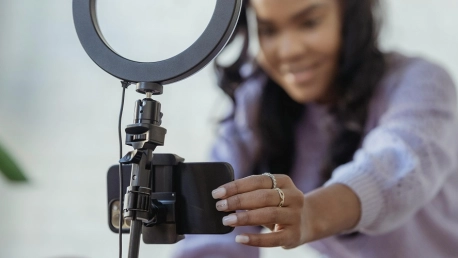It looks like social media, and especially TiKToK, have taken a different approach to how people can sell their products online. There has been a shift in the approach of influencers when it comes to promoting products. Rather than encouraging their viewers to buy products they love, many influencers have gained a lot of traction by creating videos that convince people not to purchase the products. Last year, ITcurated posted about the deinfluencing trend, but it is time to see how it is holding up in the market. Because while these videos have garnered millions of views, it raises the question – isn’t this behavior the opposite of what influencers should be doing?
To remind you, an influencer marketing platform, Room Unlocked, published statistics on British consumers who said they lost respect for influencers who consistently sell things. Around 64% of the surveyed audience has become skeptical of traditional creators. So it seems logical that in an ocean of videos trying to push a product in your face, some people would jump on the opportunity to steal the views from traditional creators by doing the opposite. But that’s what marketing has always been: a game of who will tweak the message ever so slightly to make it familiar to the audience but different enough to make it seem new and fresh.
Since influencers are dissuading consumers from excessive purchasing under the parole of challenging false advertising and nurturing authenticity, one question remains – other than our attention, what else do they stand to gain?
#Deinfluencing Under Microscope
Deinfluencing poses a challenge for marketers as much as it does for traditional creators. Besides the usual ever-changing dynamics of influencer marketing, they now also have to confront ethical questions like whether the brand values are in line with the creators they are paying, and how genuine are the connections with their audience. These rebels are disrupting the market, first emerging from the Beauty and Lifestyle landscapes, but they have spread to other categories and popular items. Seeing people going against the grain and busting myths around over-hyped products is refreshing.
As of writing, the new TikTok trend’s hashtag #deinfluencing has over a billion views. The Drum, a creative testing platform, conducted two separate pieces of research around the Dyson Air Wrap and the Stanley Quencher Tumbler to showcase how deinfluencers can affect brands in a disruptive way. They questioned a control group against a content-influenced group and found that trending deinfluencer TikToks negatively affected both companies’ brand likeability and purchase intent. The Drum concluded that the influencers are here to stay, and brands should build strategies with that in mind if they want to stay ahead of the curve.
- I don’t believe that anything happens by chance, says Lia Haberman for CBC, an adjunct professor of influencer marketing from Canada. Influencers are highly strategic and intentional. Their strategy is more about curation rather than an anti-consumer message. Lia, who recently published an article putting the deinfluencing trend under a microscope, says deinfluencers will still suggest their favorite product right after bashing others. The message is not necessarily about consuming less but more thoughtfully and intentionally.
- Lauren Rutherglen, a Calgary-based deinfluencer, sees the trend of making more thoughtful spending choices gaining momentum because people are concerned about their employment status and the looming recession. People need to know they are buying things that have value and reflect their hard work and earned money.
In January 2023, a social media scandal now called Mascaragate was a major catalyst for the rise of deinfluencing. Mikayla Nogueira posted a paid review for L’Oréal Telescopic Lift Mascara, which was a false advertisement, considering she used fake lashes to fabricate the effect of the mascara. The incident went viral and only pushed tired consumers away from buying the product and further fueled the popularity of underground deinfluencing videos.
Deinfluencers vs. Influencers: The Battle for Consumer Ideals
People were already getting exhausted from the constant product pushing on social media, but it seems the scandal was the last straw. After the Mascaragate controversy, consumers saw their value in the product-to-market dynamic and demanded greater transparency from brands. The general consensus was that social media creators only promote consumerism and materialism. TikTok was the first to say it aloud, although YouTube had seen its fair share of minimalism content on its platform by that point. Deinfluencers who fought against the desire to accumulate material items like clothes, make-up, or gadgets were welcomed with open arms. They rejected society’s obsession with wanting a multiple of everything and encouraged people to avoid overpriced trends and items.
- Canadian deinfluencer Michelle Skidelsky is a “capsule wardrobe influencer” or a fast-fashion influencer. Her message to her TikTok followers, 173 thousand of them, is that they don’t need new clothing for every season: It is expensive and unsustainable. Also, forget about updating your summer collection with sunglasses, purses, belts, and totes every year. Michelle says you shouldn’t buy multiple items you don’t need.
- Aria Connor, a lifestyle social media creator, claims there are many fake deinfluencers. She has seen some toxic behaviors like making people feel bad for their spending habits and then turning around and offering them a different product. Aria just sees them as concealed influencers and would prefer if people called this trend a “difference of opinion” instead of deinfluencing.
Another positive aspect of this trend is its potential to reduce the negative impact of influencer culture on the environment. Big influencers promote fast fashion giants like Shein or Old Navy, making nearly 10% of the world’s CO2 emissions and 1/5 of the global water pollution problem, which is not only alarming but truly disturbing. According to ResearchGate, worldwide shipping also contributes to 3% of global greenhouse gas emissions. Well, it appears that deinfluencing heroes have not come too soon to our rescue.
Will they be able to influence us to stop consuming things we throw out the moment the next trend comes out, and help us build a more sustainable culture by rejecting materialism? Let’s crunch some numbers.
Myth Busted: Influencers Thrive Amid Deinfluencing Discourse
Narratives proclaiming the end of the influencer era have persisted since its inception. From influencers facing backlash to FTC’s rules about advertising disclosures to Instagram hiding likes or the overall impact of the pandemic, influencers have persevered, and the predictions of their demise have been proven wrong. Despite all the negative news in the media, influencers’ authenticity and relatability are still going strong.
Furthermore, it is doubtful that anyone, especially the experts in digital marketing, have truly believed that the social media trend would be the end of capitalism. Not to diminish the positive impact deinfluencers have made on our society, but it is still a minimal impact.
As an example, despite deinfluencing being such a popular hashtag on social media, TikTok has introduced the TikTok shop amid the discussion. What was once a platform free from the shackles of hard sales, where you can relax and entertain yourself, is now a chaotic feed filled with videos marked by an orange shopping cart tag. Gone are the days of subtle product promotion, when you would sparsely and casually see a mention of a beauty or lifestyle item. Now, we have an influx of cheap goods from platforms like Temu or AliExpress and an unfortunate trend of amplified consumerism.
Insights into the Booming Influencer Economy:
The State of Influencer Marketing 2023 Benchmark report has estimated that the influencer marketing industry would grow to 21.1 billion USD in the last year alone. What we actually saw in 2023 was an influencer marketing spend of 26.09 billion USD. Most of this expenditure comes from companies trying to appeal to younger audiences, and they do it through influencer collaborations. Although it seems there are many people fighting against capitalism online, the creator economy is far from over. Numbers show that influencers are still good at building a personal rapport with followers and establishing trust, which they leverage to promote brand products.
According to Matter Communications, consumers seek influencers who keep it real. 69% of their respondents turn to family members, friends, or influencers to get ideas and recommendations instead of trusting the brand directly. We get it – statistics show some numbers are in favor of influencers, and some still support the deinfluencing trend, so it’s hard to know who to trust, especially if you’re a small digital marketing agency team who is trying to figure out their next strategy on a tight budget. But from what we can see, the influencer economy is booming with no signs of slowing down. If you don’t trust us, trust Goldman Sachs, which warns that the number of social creators will rise between 10 and 20% in the next five years. They predict the market will continue to expand beyond the big 26 billion worth of bang we saw last year, which already exceeded all forecasts.
Conclusion
Deinfluencers differ from traditional creators in their dislike of overpriced, potentially harmful, or unethical purchases. Their odd approach was well-received and celebrated, creating a unique niche in influencer culture conditioned by honesty, subjectivity, and credibility, at least at first glance. A trait not always guaranteed among traditional creators. However, we cannot lose sight of the fact that deinfluencers are still influencers, which means someone will eventually plaster an ad over a face that has clout.
Despite deinfluencing efforts from minimalists around the globe, the atmosphere surrounding social media promises only to get more toxic. Unfortunately, the capitalistic ideology to grow at all costs is not slowing down. And right now, regular people are effective salespeople across the social media multiverse. The audiences relate to their peers, finding similarities in lifestyles and lived experiences with people who look and behave like them. This connection makes them valuable to marketers and corporations but has made identity a commodity, where a priceless thing like a human bond can be sold.









